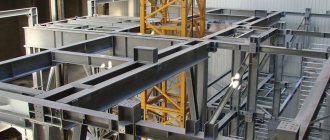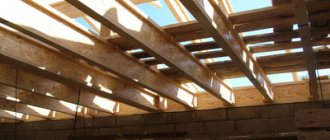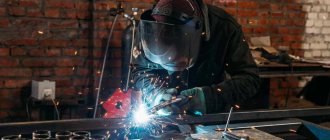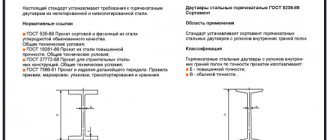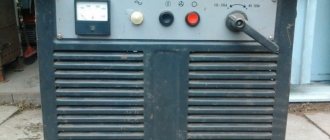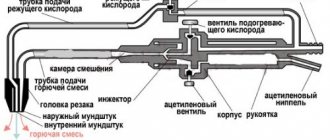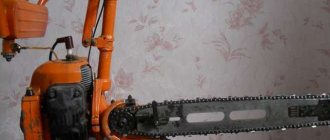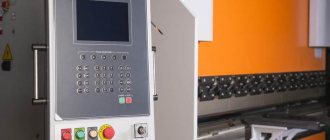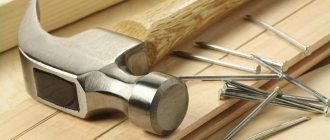Welding technologies are very important for modern metallurgy, especially when it is necessary to create high-strength and heavy metal structures. Moreover, the welding operation speeds up the work process, and also not much equipment is needed to carry out welding, so it can be considered very economical. It is for these reasons that the production of welded beams has recently increased several times.
§ 116. Beam structures
Beams are widely used in the structures of civil and industrial buildings, in bridges, overpasses, hydraulic engineering and other structures.
Beams with a solid wall section are made of sheet metal. Mostly I-beams are used, less often - box-shaped ones.
In single production conditions, beams are assembled according to markings and welded manually with coated electrodes or semi-automatic machines. In mass and serial production, assembly is carried out in jigs, and welding is carried out using automatic submerged arcs or for seams with a leg of 4 - 6 mm - in shielding gas.
Manual or semi-automatic arc welding is used in beams and when installing stiffeners. Inconveniences during this operation do not allow the use of automatic welding.
Extension of beams by butt joining of short sections is carried out by manual arc welding with coated electrodes. In mass production, automatic arc welding is also possible in this operation.
When installing beams, the butt welds are welded first, and then the fillet welds. The procedure for welding assembly joints of rolled beams is shown in Fig. 150, a
. First, butt welds are performed on thick metal, and then on thin metal. Typically, the flanges of I-beams are thicker than the web. Therefore, to ensure minimal stresses in the joint metal, the butt welds in the flanges should be laid first and, lastly, the butt weld in the wall.
During installation, welded beams are connected to the combined one (Fig. 150, b
) or with a displaced (Fig. 150,
c
) joint.
Rice.
150. The procedure for welding assembly joints of beams: a - rolled, b and c - welded; 1 - 4 - welding sequence The welding sequence in these cases is similar to the sequence of butt welding of rolled beams; first of all, the butt seam of the flange is made with increased thickness (if the I-beam has different thicknesses of the flanges), then the second butt seam of the second flange is applied, the wall joint is welded with the third seam (the thinnest in the I-beam) and the fourth is the corner waist seams (Fig. 150). Longitudinal welds usually do not extend to the ends of the beam by an amount equal to one flange width (mild steel) or two (alloy steel). In these cases, the deformation and stress of the metal in the butt joints of the flanges and the entire butt joint of the beam will be uniform and minimal. Fillet welds in the assembly joint are made last. In this case, it is desirable that fillet welds are applied simultaneously by two welders - from the ends to the middle of the seam.
Stiffeners can be welded both to the wall and to the flange of the beam in any sequence after preliminary tacking. Tacks are placed at the locations of the welds. The height of the tacks should be no more than 2/3 of the height of the seam, so that during subsequent welding they will be covered by the seam, and not less than 4 - 6 mm for tacked stiffeners with a thickness of 6 mm or more. The length of each tack should be equal to 4 - 5 times the thickness of the elements being tacked, but not less than 30 mm and not more than 100 mm, and the distance between the tacks should be 30 - 40 times the thickness of the metal being welded.
Calculation and production of welded I-beam
High-quality welding of I-beams for floors will require a lot of attention and responsibility from you. You will need to calculate all the upcoming loads on the structure in general and on the joints of the beams themselves.
The modern market offers a fairly large variety of sizes of finished I-beams with their own designations and types. The dimensions of the beam are determined by the number, which indicates the distance between the outer edges parallel to each other.
For example, the marking K denotes columns and beams that must withstand enormous loads. Keep in mind that there is also a certain type of beams that are not used for floors, but only for creating heavy equipment and machinery. Such beams have their own manufacturing standards and properties.
Wide-flange designs are suitable for lighter loads. And the strength of such beams will directly depend on the length, the formula of the transverse profile, the use of raw materials and manufacturing methods, i.e. metal rolling technologies. Here is a standard welded beam for private housing construction:
Here are the parameters of welded steel I-beams for the manufacture of such beams:
How to weld a beam yourself?
If you already have some experience working with this material and you want to make welded beams for building your house yourself, you will need an alloy steel sheet as a base. The hot-rolled method of manufacturing at home is quite complicated, so welding is really better for you. This is a responsible task, so if you have the opportunity, it is more rational to immediately invite an experienced welder.
After the individual elements are ready, assemble the structure using the selected welding method. First you will need to install a vertical wall and secure the stiffeners and press everything down with clamps. The finished beam must be protected with a special coating so that it does not corrode in an aggressive environment.
How to avoid deformation?
If you make mistakes during the manufacturing process, you may encounter such unpleasant deformations of the beam, which in the future will significantly complicate the installation process:
Let us explain in more detail. Your main task when making welded beams is to then join the parts so that the seam does not work in tension.
You also take into account this important fact that the welding itself puts some stress in the beam, and this is not always noticeable to the eye. Therefore, it is advisable not to immediately weld the next part to it. Just push the seam back slightly and the beam will be level.
Comparisons: in order to avoid any deformation of the beam, especially for arranging an interfloor floor, it is subjected to special processing in the factory:
If you undertake making such a beam yourself, the following steps will help you figure it out:
This is interesting: Electrodes for welding stainless steel: welding stainless steel correctly
Welding I-beams
Beam I-beams of standard sizes are produced in industrial quantities; small batches are made according to individual drawings. The welded beam consists of three elements: two walls and an intermediate belt. It is made from branded sheet metal and is used in high-strength metal structures. With little metal input, reliable structures are obtained that can withstand multidirectional loads due to stiffening ribs.
Application area
Prefabricated buildings and structures are created with supporting and load-bearing metal frames; floors and trusses are made from them. When using welded I-beams, the weight of buildings is reduced and they do not require a powerful foundation.
The welded I-beam is characterized by high strength, durability, and is not subject to fatigue failure. It is used in heavy engineering; it is used to make elements that experience high pressure and are subject to rupture.
Unlike I-beam wire rods, welded wire rods are not limited in size. By welding strips, beams of any section and length are obtained. Architects are not limited in their flights of fancy.
The manufacturing process for I-sections produces little waste. They can be made with shelves and walls made of different grades of steel: in places of minimal stress, carbon steel or perforated steel sheets are used, loaded parts are made of alloy rolled steel.
Additional functions of an I-beam in private housing construction
The floor itself does not necessarily have to consist only of metal I-beams. Often they are used only in the most intense places, and wooden I-beams are installed between the metal parts.
Why is that? The fact is that welding requires highly qualified workers. Further, in ordinary literature and Internet sites there is not that variety of components and ready-made design diagrams for installing such a ceiling; a competent engineer is really required here, and even we only give recommendations. In addition, metal is not cheap. And the quality of welding is very important. It must work for a long time, even under conditions of corrosion or changing loads.
Therefore, this option not only has the right to life, but is also quite practical:
And finally, a metal I-beam often serves as an additional functional element, which has value in any household:
Types of metal welded beams
Continuous production of I-beams for various purposes has been established. According to the standard, there are several types of I-beams:
- with a short shelf length in relation to the partition, they are used for overhead tracks, floors, and strengthening of mine workings;
- with the proportional size of the partition and shelves, they are used in the construction of support frames and reinforcement of decorative columns.
According to manufacturing accuracy, there are two types of I-beam profiles: regular and high-precision.
Classification of hot-rolled I-beams
According to the cross-sectional shape, hot-rolled I-beams are divided into two groups: with a slope of the internal edges of the flanges (manufactured according to GOST 8239-89 and 19425-74 for special types) and with parallel edges of the flanges (GOST 26020-83).
I-beam with sloped internal edges of the flanges
Products manufactured in accordance with GOST 8239-89 have an acceptable edge slope of no more than 12%. Rolling accuracy: increased (“B”) and normal (“C”).
Special purpose beams (GOST 19425-74) are used for:
- “M” – structures of overhead tracks (the slope of the internal edges of the shelves is no more than 12%);
- “C” – reinforcement of mine shafts (slope can reach 16%).
Production technology of welded I-beams
Small batches are made using electric arc or argon welding, depending on the grade of metal and its ability to be welded.
To produce welded beams industrially, special welding lines are used. Fluxes are used to protect the melt pool from oxidation.
Welding a beam in automatic mode is similar to manually making an I-beam. Main technological stages:
- cutting rolled sheets into strips of the required width using a thermal cutting machine with program control, average cutting speed 1 m/min.
- end milling on end milling machines reduces the joint gap between the wall and the shelf and improves the quality of welding;
- the process of assembling an I-beam is carried out at high speed on a special machine; metal strips are fixed by clamping devices with hydraulic amplifiers; first a T-shaped joint is made, then the second wall is added; this design is convenient to weld;
- welding work is carried out using portal-type machines of two types: a) two seams are shallowly welded at once using inclined electrodes; b) the boat seam is created in stages: first on one side of the I-beam, then on the other; the metal is boiled to a great depth;
- the final stage is straightening the I-beam on special rollers; minor distortions that arose during assembly and welding of the profile are eliminated.
General information
A welded beam is a type of beam structures that are made by welding individual metal blanks. The main material for the production of this type of spare parts is steel, which may contain small amounts of manganese, chromium, vanadium, titanium or lead. They are usually made in the form of I-beam structures resembling the letter “H”. The design itself looks like this:
- In the middle of the part there is a long flat jumper part with a constant width. To obtain tapering I-beams, metal bridges of variable width can be used when the width of one edge is less than the width of the other edge. Such spare parts are used for mounting suspended structures or fastenings.
- On the sides, two parts are welded perpendicularly to the jumper, which act as a kind of “walls”. The walls have a constant width, although sometimes tapering walls can be used if it is necessary to create a ceiling.
- For marking, a “stamp” can be applied, which will reflect basic information about the spare part. Key information - metal grade, spare part type, part category, production date, information about the manufacturer.
Possible defects
During welding of an I-beam, due to non-compliance with the technology, crystallization of the steel occurs due to high temperature. Due to phase discrepancies, internal stresses arise in the metal. Strength and rigidity decrease, and the risk of corrosion increases.
When welding steel sheets, other defects are possible:
- violation of the shape of the seam; deviation from the shape of the outer surfaces or the geometry of the joint;
- burns, when the melt flows out of the bath, holes form in the seam;
- undercuts – grooves along the joint boundary;
- cracks forming in places where the seam breaks;
- slag or tungsten inclusions in the diffusion layer; at high welding speeds, refractory oxides are formed.
Metal products with defects are unreliable; they will not withstand heavy bending or torsion loads. They are discarded and boiled again if possible.
Welding I-beams together
Installation of beam metal structures involves connecting I-beams end-to-end or at an angle. To strengthen the connections, metal plates are used - rectangles cut from sheet metal.
Butt welding of beams is carried out after processing the ends. Angular bevels are made on them so that the seam is well welded. Additionally, pads must be attached to each side of the walls and both shelves; they are welded to strengthen and protect the connecting seam. With this connection, the supporting structure of I-beams does not decrease after welding.
The I-beams are connected at an angle so that the secondary one rests on the main one. An isosceles triangle with an apex of 90° is cut out in the top shelf of the main one. Its place will be taken by a similar insert of a secondary I-beam; the sections should fit tightly to each other. The bottom flange is cut ½ of the width so that the cut rests against the flange of the main I-beam. Welding is flush. The connection is strengthened by the bottom pad.
The secondary channel is welded to the supporting I-beam at an angle of 90°. First, the upper flange of the channel is joined to the beam flange, cutting them at an angle of 45°. The lower flanges are connected so that the channel rests against the wall of the I-beam, and the excess is cut off. Then the lower reinforcing pad is welded on.
It is easier to weld in a horizontal position. The longitudinal axis is bent minimally. During vertical welding, deflection of the cross members is possible, so all stiffeners are marked.
The pads for welding I-beams are cut out in the shape of a rhombus and placed symmetrically to the longitudinal axis. They are scalded with oblique seams along the entire perimeter. The overlays concentrate stress at the seams, compensating for the section shape that has changed after welding.
I-beams are designed for heavy loads. When working with them, you must adhere to the developed technology. It takes into account the distribution of forces along the guides. High-quality connections are the key to long-term operation of metal structures.
Welding an I-beam at the enterprise. Let's reveal the secret of production
Welding an I-beam at the enterprise. Let's reveal the secret of production
We reveal the secrets of the manufacturing process of welded I-beams. Manual, semi-automatic and automatic welding of I-beams.
I-beam welding is a technology that has replaced old-fashioned rivets and pins in the manufacture of I-beams.
Even 20 - 30 years ago, the construction industry used beams held together by rivets, bolts and pins. This fastening technology had many disadvantages. Starting with a significant complication of the construction and installation process and an increase in the number of components, which in turn led to a significant increase in the cost of construction. And ending with a serious increase in the weight of the beam structure, which increased the load on the load-bearing elements of the building and, as a result, reduced the freedom of action of designers when creating multi-story structures. However, modern construction technologies and designs are constantly developing and improving. The result of this development was the emergence of welded metal structures.
The main advantages of using welded I-beam structures
A design such as an I-beam has a number of advantages that distinguish it from other metal structures used in construction:
- Welded I-beam metal structures are able to withstand enormous static and dynamic loads without losing their performance characteristics. Due to these characteristics, in most cases, reinforcement of the I-beam is not required.
- Ease of transportation and relative ease of installation make I-beam elements indispensable in the construction of prefabricated structures.
- Such beams are extremely popular and are widely used for the construction of buildings and structures for a wide variety of purposes, so their prices are quite affordable. To purchase such metal structures, just go to the website of the nearest manufacturer and go to the section - selling I-beams. Most companies offer a wide range of I-beam metal structures available in stock, and also manufacture them to order. Also, by calling the marketing department, it is easy to find out how much a beam of the brand you are interested in costs, depending on the tonnage.
Possibilities
In addition to the advantages, the use of welded steel beams will allow each buyer to:
- Increase the width of the building span, as they are longer;
- Order different parameters and sizes, there are a huge number of GOST standards for I-beams, so that every customer can find suitable parameters;
- The architecture of the structure, as mentioned above, can be completely diverse.
Thus, the welded beam has a huge number of advantages, which is why it is widely used in all areas of construction. The use of welded beams has helped people improve the quality of structures of buildings and various structures, increase their safety, and therefore safety for people.
Manufacturing of I-beam metal structures
The process of manufacturing metal beams with an H-shaped (or I-beam) section is quite complicated. To obtain a high-quality design, it is necessary to use proven high-quality raw materials, modern high-tech production mechanisms, as well as the presence of highly qualified personnel. At the same time, high-quality incoming control, comprehensive control of all stages of manufacturing and processing of elements, as well as control of products at the output are required. Only this approach to production can guarantee the highest quality and performance characteristics of the finished product.
Welding work in the manufacture of I-beam metal structures
Welding of I-beams at large metalworking enterprises takes place on a modern automated line. The beam enters a special conductor, inside of which the waist seams of the future metal structure are welded under a layer of flux, in a fully automatic mode.
This welding of I-beams ensures maximum quality of seam connections due to the use of a protective layer of flux. During welding work, a layer of flux protects the weld, which allows minimizing the splashing of hot drops of metal, without compromising the welding speed and quality of the connection. Also, thanks to the flux layer, the cooling of the welded joint occurs much more smoothly and evenly. With this method of welding, reinforcement of the I-beam is not required, due to the maximum strength and reliability of the manufactured structure.
- Low speed of welding work.
- Quite mediocre quality of welds, in comparison with automatic submerged arc welding.
- Insufficient geometric accuracy of the finished product due to manual assembly, overheating and, as a consequence, large deformations, in contrast to the automated welding process.
- Serious losses (up to 30 percent) of metal due to strong splashing of hot metal drops during welding.
Bottom line
As can be seen from the above, welded I-beam metal structures have a number of advantages in comparison with other types of beams. Welded I-beams have found their niche in the modern construction market and are used according to their strengths and weaknesses. The production of such metal structures has been launched in most regions of our country, which makes the I-beam an accessible and relatively inexpensive building material. Therefore, due to the high competition in this niche, any seller, when asked “I will sell an I-beam,” will provide good discounts and advantageous offers.
Advantages of welded I-beams
Nowadays, it is very difficult to find a construction project that was erected without the use of welded I-beams. Beams with this cross-section are widely used because they can significantly reduce the costs of constructing structures for various purposes, while ensuring high reliability of the structures being built.
A welded beam, the cross-section of which has the shape of an I-beam, is capable of withstanding significant static and dynamic loads without losing its performance characteristics. An important factor is that the use of such welded beams makes it possible to reduce the weight of building structures, which ultimately reduces the load on the foundation of the building and on its supporting structures.
The use of I-beams in the manufacture of a building frame
A welded I-beam is especially indispensable in those elements of building structures where strength and the ability to successfully withstand mechanical loads of various directions are especially important. Such elements, in particular, include frames for various structures, columns, interfloor ceilings, overpasses, work platforms, etc.
Welded beams are in great demand in various branches of mechanical engineering and in the construction of prefabricated structures, since the technology for its production is very economical.
Despite the fact that it is quite simple to organize the production of welded I-beams, it is more economically profitable to produce them using automated equipment. Automated lines on which the production of such welded beams is put on stream allow not only to significantly reduce the cost of production, but also to strictly adhere to the technology of its production.
Floors on metal I-beams
What does it represent?
According to the production method, I-beams are divided into welded and hot-rolled.
The welded I-beam is assembled from three strips of durable high-carbon steel using electric arc welding.
The advantages of this design over hot-rolled ones are:
- the ability to carry high loads, this makes the element suitable for covering large spans;
- a special profile increases rigidity and resistance to bending, since the upper strip works in compression, and the lower one in tension;
- ability to work in difficult conditions, with changes in temperature and humidity, in aggressive environments;
- after strength calculations, reduce the linear weight of rolled products and the total weight of structures;
- possibility of manufacturing beams with asymmetrical and variable cross-section length.
I-beams are perfect for the construction of prefabricated structures . They are widely used in commercial and industrial, as well as in public and private construction.
Despite the high weight of steel beams, their increased load-bearing capacity can significantly reduce the overall weight of the building.
This is interesting: Rhombic corrugated sheet: characteristics, production, GOST
How to weld I-beams
The design of the assembly equipment used to manufacture welded beams having an I-section is determined by the welding method used to form the waist seams. The choice of such equipment also depends on what devices are planned to be used in the production process. At modern enterprises, automatic submerged arc welding is most often used to form long belt seams of I-beams. This method allows us to obtain welds of high quality and reliability along their entire length.
Beam welding as a stage of its manufacture
The use of automated equipment for welding under a layer of liquid flux to produce I-beams allows not only to reduce the cost of the finished product, but also to ensure its high quality and reliability. The operating principle of such equipment provides that the unmelted flux protecting the welding zone is under pressure. Thanks to this, the splashing of liquid metal from the welding zone is minimized, which allows this operation to be performed efficiently even at high current values (up to 4 thousand Amperes). In addition, the flux protects the molten metal from rapid cooling, which facilitates more efficient removal of gas from it.
Meanwhile, the welded beam can be produced using manual arc and semi-automatic welding. In such cases, special conductors with clamping elements, or ordinary tacks and clamps are used to assemble them. However, it should be borne in mind that in this case you will have to deal with large losses of molten metal, which will occur due to its splashing and waste. Such losses can reach up to 30%.
Features and Benefits
A welded I-beam is made from sheet steel, which is cut into individual plates. To fasten the plates, the following operations are performed: edge cleaning, milling and metal welding. The main advantage of welded beams is their low metal consumption and simplicity. No equipment is needed to produce an individual spare part, and the cost of sheet steel will be minimal. The welded beam has high strength and reliability, does not deform under high loads, and withstands the effects of chemical reagents and high temperatures.
The main area of application of I-beams is the construction of various objects - houses, warehouses, factory premises, frame structures. I-beams are suitable for creating long spans, overpasses, bridges, floors, platforms, and crane structures. Depending on the type of structure, there are several types of I-beams - normal, wide-flange, column, sloped, reinforced. The use of welded beams in construction has many advantages:
- Reduction in the total weight of the structure by 10-20%. This is achieved due to the fact that welded I-beams are produced in different sections. This allows you to select a part to create any design.
- Universal composition. The metal welding method allows you to connect almost any type of steel, so an I-beam can be made even from dissimilar materials. This simplifies the selection of steel and reduces the cost of producing spare parts.
- Possibility of creating asymmetrical walls. Welding can be used to connect any metal surface. Therefore, it can be used to connect even metal walls that are asymmetrically located relative to each other.
- Minimum scraps and debris. A welded I-beam is made from flat blanks, which are created by cutting metal sheets. During welding, a minimum of debris is generated. Therefore, this production technology is economical, and cuttings are generated to a minimum during operation.
